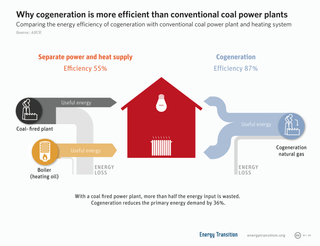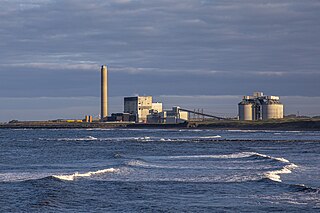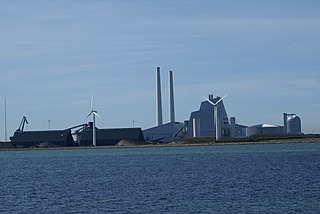
Gasification is a process that converts biomass- or fossil fuel-based carbonaceous materials into gases, including as the largest fractions: nitrogen (N2), carbon monoxide (CO), hydrogen (H2), and carbon dioxide (CO2). This is achieved by reacting the feedstock material at high temperatures (typically >700 °C), without combustion, via controlling the amount of oxygen and/or steam present in the reaction. The resulting gas mixture is called syngas (from synthesis gas) or producer gas and is itself a fuel due to the flammability of the H2 and CO of which the gas is largely composed. Power can be derived from the subsequent combustion of the resultant gas, and is considered to be a source of renewable energy if the gasified compounds were obtained from biomass feedstock.

Drax power station is a large biomass power station in North Yorkshire, England, capable of co-firing petroleum coke. It has a 2.6 GW capacity for biomass and 1.29 GW capacity for coal. Its name comes from the nearby village of Drax. It is situated on the River Ouse between Selby and Goole. Its generating capacity of 3,906 megawatts (MW) is the highest of any power station in the United Kingdom, providing about 6% of the United Kingdom's electricity supply.

Cogeneration or combined heat and power (CHP) is the use of a heat engine or power station to generate electricity and useful heat at the same time.
Redbank Power Station is a biomass power station located in Warkworth, within the Hunter Region of New South Wales, Australia. The station is currently awaiting a restart of operations after converting from its original use as a coal-fired power station. Redbank is unique for its utilisation of circulating fluidised bed technology, the only generator of its kind in Australia. Upon re-fire, the station will operate using 100% biomass at a capacity of 151MW of electricity.
A bio-energy village is a regionally oriented concept for the use of renewable energy sources in rural areas. The system uses biomass from local agriculture and forestry in a biogas powerplant to meet the complete energy requirements of a village, such as electricity and district heating.

Ghana generates electric power from hydropower, fossil-fuel, and renewable energy sources. Electricity generation is one of the key factors in order to achieve the development of the Ghanaian national economy, with aggressive and rapid industrialisation; Ghana's national electric energy consumption was 265 kilowatt hours per capita in 2009.

Lynemouth Power Station is a biomass power plant which provides electricity for the UK National Grid. Until March 2012, it was the main source of electricity for the nearby Alcan Lynemouth Aluminium Smelter. It is located on the coast of Northumberland, north east of the town of Ashington in north east England. The station has stood as a landmark on the Northumberland coast since it opened in 1972, and had been privately owned by aluminium company Rio Tinto Alcan throughout its operation until December 2013, when RWE npower took over. In January 2016 it was acquired by Energetický a průmyslový holding.

The Tilbury power stations were two thermal power stations on the north bank of the River Thames at Tilbury in Essex. The 360 MW dual coal- and oil-fired Tilbury A Power Station operated from 1956 until 1981 when it was mothballed, prior to demolition in 1999. The 1,428 MW Tilbury B Power Station operated between 1968 and 2013 and was fueled by coal, as well as co-firing with oil and, from 2011, biomass. Tilbury B was demolished in 2016–19. Since 2013 three other power stations have been proposed or constructed in Tilbury.

North Tees Power Station refers to a series of three coal-fired power stations on the River Tees at Billingham in County Durham. Overall, they operated from 1921 until 1983, and the C station, the last on the site, was demolished in 1987. Billingham Biomass Power Station is to be built on their site.

The Wilton power station refers to a series of coal, oil, gas and biomass fired CHP power stations which provide electricity and heat for the Wilton International Complex, with excess electricity being sold to the National Grid. It is located on the Wilton site in Redcar and Cleveland, south of the town of Middlesbrough in North East England. The station has provided for the site since opening in 1952, when it was operated by ICI. The station is currently owned and operated by SembCorp Industries.

Teesside Energy from Waste plant is a municipal waste incinerator and waste-to-energy power station, which provides 29.2 megawatts (MW) of electricity for the National Grid by burning 390,000 tonnes of household and commercial waste a year. It is located on the River Tees at Haverton Hill, east of Billingham in North East England. Developed and built by NEM, a subsidiary of Northumbrian Water, the initial plant replaced the Portrack Incinerator and opened in 1998. Subsequently, the facility became part of SITA, now Suez.

The North Blyth Biomass Project was a proposed biomass-fired power station planned to be located at North Blyth, Northumberland on the north bank of the River Blyth near its tidal estuary. When commissioned it would have had a generating capacity of 100 megawatts, enough electricity to provide for 170,000 homes. Renewable Energy Systems, the station's developer, was granted government consent on 24 July 2013 to build the £250m project.
Tees Renewable Energy Plant is a proposed biomass fueled power station situated on the River Tees at Teesport in Redcar and Cleveland, North East England. The plant will operate alongside other renewable energy units and industrial processes operating in the Northeast of England Process Industry Cluster (NEPIC)

The Avedøre Power Station is a combined heat and power station, located in Avedøre, Denmark, just south of Copenhagen, and is owned by Ørsted A/S. Avedøre Power Plant is a high-technology facility and one of the world's most efficient of its kind, being able to utilize as much as 94% of the energy in the fuel and convert 49% of the fuel energy into electricity. Apart from using coal, petroleum (oil) and natural gas, the plant runs on a wide variety of biomass fuels such as straw and wood pellets. The plant consists of two units with a total capacity of 793 MW of electricity and 918 MW of heat. The combination of producing electricity and heat for district heating at the same time is widely used in Denmark and the rest of Scandinavia, due to the need of domestic heating together with the Danish energy companies putting a big effort into optimising the energy plants.

Dalkia is an energy service company, subsidiary of the EDF Group. Its two main businesses consist in making the most of local renewables and unlocking energy savings. Dalkia develops alternative renewables, such as biomass, geothermal, biogas and recovered energies.
The T2 Energy Centre is a biomass-fuelled combined heating and power (CHP) station at Heathrow Airport in London which opened in December 2012. It provides heat to half of the active terminals: Terminal 2 and Terminal 5 and electricity into the local grid, similar to some of the airport's operations demands.

Elean power station is a straw-fired biomass power station in Cambridgeshire, England. At a capacity of 38 MW, it was the largest straw-fired power plant in the world at the time of its completion. The power station was constructed between 1998 and 2000 by FLS Miljo and is operated by EPR Ely Ltd. It generates 270 GWh of electricity from 200,000 tonnes of biomass annually, supplied by Anglian Straw Ltd. Straw is the major fuel of the plant, but oilseed rape and the energy crop Miscanthus are also used, as well as some natural gas.
Denmark is a leading country in wind energy production and wind turbine production. Wind power alone produced 47% of Denmark's electricity consumption in 2017, and is expected to increase its production by nearly 80% in the years to 2024.
Biofuels play a major part in the renewable energy strategy of Denmark. Denmark is using biofuel to achieve its target of using 100% renewable energy for all energy uses by 2050. Biofuels provide a large share of energy sources in Denmark when considering all sectors of energy demand. In conjunction with Denmark's highly developed renewable energy resources in other areas, biofuels are helping Denmark meet its ambitious renewable energy targets.
Templeborough Power Station is a biomass power station situated in Templeborough on the River Don in Rotherham England. Operated by Copenhagen Infrastructure Partners, it opened in 2018 with an operating capacity of 44 megawatts.















